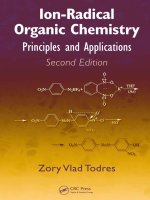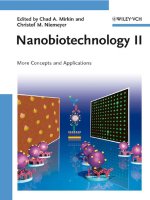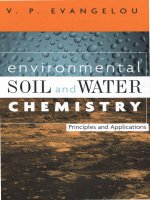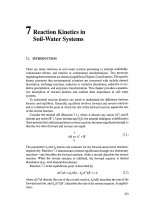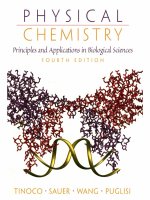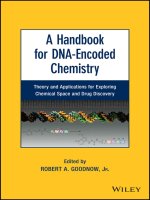Organic chemistry concepts and applications
Bạn đang xem bản rút gọn của tài liệu. Xem và tải ngay bản đầy đủ của tài liệu tại đây (45.07 MB, 621 trang )
Organic Chemistry
Organic Chemistry
Concepts and Applications
Allan D. Headley
Texas A&M University
Commerce, Texas, USA
This edition first published 2020
© 2020 John Wiley & Sons, Inc.
All rights reserved. No part of this publication may be reproduced, stored in a retrieval system, or transmitted,
in any form or by any means, electronic, mechanical, photocopying, recording or otherwise, except as
permitted by law. Advice on how to obtain permission to reuse material from this title is available at
/>The right of Allan D. Headley to be identified as the authors of this work has been asserted in accordance with law.
Registered Office
John Wiley & Sons, Inc., 111 River Street, Hoboken, NJ 07030, USA
Editorial Office
111 River Street, Hoboken, NJ 07030, USA
For details of our global editorial offices, customer services, and more information about Wiley products visit us at
www.wiley.com.
Wiley also publishes its books in a variety of electronic formats and by print‐on‐demand. Some content that appears
in standard print versions of this book may not be available in other formats.
Limit of Liability/Disclaimer of Warranty
In view of ongoing research, equipment modifications, changes in governmental regulations, and the constant flow
of information relating to the use of experimental reagents, equipment, and devices, the reader is urged to review
and evaluate the information provided in the package insert or instructions for each chemical, piece of equipment,
reagent, or device for, among other things, any changes in the instructions or indication of usage and for added
warnings and precautions. While the publisher and authors have used their best efforts in preparing this work, they
make no representations or warranties with respect to the accuracy or completeness of the contents of this work
and specifically disclaim all warranties, including without limitation any implied warranties of merchantability or
fitness for a particular purpose. No warranty may be created or extended by sales representatives, written sales
materials or promotional statements for this work. The fact that an organization, website, or product is referred
to in this work as a citation and/or potential source of further information does not mean that the publisher and
authors endorse the information or services the organization, website, or product may provide or recommendations
it may make. This work is sold with the understanding that the publisher is not engaged in rendering professional
services. The advice and strategies contained herein may not be suitable for your situation. You should consult with
a specialist where appropriate. Further, readers should be aware that websites listed in this work may have changed
or disappeared between when this work was written and when it is read. Neither the publisher nor authors shall
be liable for any loss of profit or any other commercial damages, including but not limited to special, incidental,
consequential, or other damages.
Library of Congress Cataloging‐in‐Publication Data
Names: Headley, Allan D., 1955– author.
Title: Organic chemistry : concepts and applications / Allan D. Headley
(Texas A&M University).
Description: First edition. | Hoboken, NJ : Wiley, 2020. | Includes
bibliographical references and index. |
Identifiers: LCCN 2019018485 (print) | LCCN 2019020628 (ebook) |
ISBN 9781119504627 (Adobe PDF) | ISBN 9781119504672 (ePub) |
ISBN 9781119504580 (pbk.)
Subjects: LCSH: Chemistry, Organic–Textbooks.
Classification: LCC QD251.3 (ebook) | LCC QD251.3 .H43 2020 (print) | DDC
547–dc23
LC record available at />Cover Design: Wiley
Cover Images: Background © Sean Nel/Shutterstock, Chemical images courtesy of Allan D. Headley
Set in 10/12pt Warnock by SPi Global, Pondicherry, India
Printed in the United States of America
10 9 8 7 6 5 4 3 2 1
v
Contents
Preface xvii
About the Campanion Website xxiii
1
Bonding and Structure of Organic Compounds 1
1.1Introduction 1
1.2Electronic Structure of Atoms 4
1.2.1Orbitals
4
1.2.2 Electronic Configuration of Atoms 6
1.2.3 Lewis Dot Structures of Atoms 8
1.3
Chemical Bonds 9
1.3.1 Ionic Bonds 9
1.3.2 Covalent Bonds 9
1.3.3 Shapes of Molecules 12
1.3.4 Bond Polarity and Polar Molecules 12
1.3.5 Formal Charges 14
1.3.6Resonance
15
1.4Chemical Formulas 18
1.4.1 Line‐Angle Representations of Molecules 18
1.5The Covalent Bond 20
1.5.1 The Single Bond to Hydrogen 20
1.5.2 The Single Bond to Carbon 21
1.5.3 The Single Bond to Heteroatoms 22
1.5.4 The Carbon–Carbon Double Bond 23
1.5.5 The Carbon–Heteroatom Double Bond 25
1.5.6 The Carbon–Carbon Triple Bond 26
1.5.7 The Carbon–Heteroatom Triple Bond 27
1.6Bonding – Concept Summary and Applications 28
1.7Intermolecular Attractions 29
1.7.1 Dipole–Dipole Intermolecular Attractions 29
1.7.2 Intermolecular Hydrogen Bond 30
1.7.3 Intermolecular London Force Attractions 31
1.8Intermolecular Molecular Interactions – Concept Summary and Applications 31
End of Chapter Problems 34
2
Carbon Functional Groups and Organic Nomenclature 39
2.1Introduction 39
2.2Functional Groups
39
vi
Contents
2.3Saturated Hydrocarbons 41
2.3.1 Classification of the Carbons of Saturated Hydrocarbons 44
2.4Organic Nomenclature 45
2.5Structure and Nomenclature of Alkanes 45
2.5.1 Nomenclature of Straight Chain Alkanes 45
2.5.2 Nomenclature of Branched Alkanes 46
2.5.3 Nomenclature of Compounds that Contain Heteroatoms 49
2.5.4 Common Names of Alkanes 50
2.5.5 Nomenclature of Cyclic Alkanes 51
2.5.6 Nomenclature of Branched Cyclic Alkanes 51
2.5.7 Nomenclature of Bicyclic Compounds 52
2.6Unsaturated Hydrocarbons 54
2.7Structure and Nomenclature of Alkenes 56
2.7.1 Nomenclature of Branched Alkenes 56
2.7.2 Nomenclature of Polyenes 57
2.7.3 Nomenclature of Cyclic Alkenes 58
2.8Structure and Nomenclature of Substituted Benzenes 58
2.8.1 Nomenclature of Disubstituted Benzenes 59
2.9Structure and Nomenclature of Alkynes 60
End of Chapter Problems 61
Heteroatomic Functional Groups and Organic Nomenclature 63
3.1Properties and Structure of Alcohols, Phenols, and Thiols 63
3.1.1 Types of Alcohols 65
3.2Nomenclature of Alcohols 66
3.2.1 Nomenclature of Difunctional Alcohols 67
3.2.2 Nomenclature of Cyclic Alcohols 67
3.2.3 Nomenclature of Substituted Phenols 68
3.3Nomenclature of Thiols 68
3.4Structure and Properties of Aldehydes and Ketones 69
3.5Nomenclature of Aldehydes 70
3.5.1 Nomenclature of Difunctional Aldehydes 70
3.6Nomenclature of Ketones 71
3.6.1 Nomenclature of Difunctional Ketones 71
3.6.2 Nomenclature of Cyclic Ketones 72
3.7Structure and Properties of Carboxylic Acids 73
3.8Nomenclature of Carboxylic Acids 75
3.8.1 Nomenclature of Difunctional Carboxylic Acids 76
3.8.2 Nomenclature of Cyclic Carboxylic Acids 76
3.9Structure and Properties of Esters 78
3.9.1 Nomenclature of Esters 79
3.9.2 Nomenclature of Cyclic Esters 80
3.10Structure and Properties of Acid Chlorides 82
3.10.1 Nomenclature of Acid Chlorides 82
3.10.2 Nomenclature of Difunctional Acid Chlorides 83
3.11Structure and Properties of Anhydrides 83
3.11.1 Nomenclature of Anhydrides 84
3.12Structure and Properties of Amines 84
3.12.1 Nomenclature of Amines 86
3
Contents
3.12.2 Nomenclature of Difunctional Amines 88
3.13Structure and Properties of Amides 88
3.13.1 Nomenclature of Amides 89
3.14Structure and Properties of Nitriles 90
3.14.1 Nomenclature of Nitriles 90
3.15Structure and Properties of Ethers 91
3.15.1 Nomenclature of Ethers 93
3.15.2 Nomenclature of Oxiranes 93
3.16An Overview of Spectroscopy and the Relationship to Functional Groups 94
3.16.1 Infrared Spectroscopy 95
End of Chapter Problems 99
4
Alkanes, Cycloalkanes, and Alkenes: Isomers, Conformations, and Stabilities 103
4.1Introduction 103
4.2Structural Isomers 103
4.3Conformational Isomers of Alkanes 104
4.3.1 Dashed/Wedge Representation of Isomers 104
4.3.2 Newman Representation of Conformers 105
4.3.3 Relative Energies of Conformers 107
4.4Conformational Isomers of Cycloalkanes 108
4.4.1 Isomers of Cyclopropane 108
4.4.2 Conformational Isomers of Cyclobutane 109
4.4.3 Conformational Isomers of Cyclopentane 109
4.4.4 Conformational Isomers of Cyclohexane 110
4.4.5 Conformational Isomers of Monosubstituted Cyclohexane 112
4.4.6 Conformational Isomers of Disubstituted Cyclohexane 113
4.5Geometric Isomers 114
4.5.1 IUPAC Nomenclature of Alkene Geometric Stereoisomers 116
4.6Stability of Alkanes 119
4.7Stability of Alkenes 121
4.8Stability of Alkynes 122
End of Chapter Problems 123
5Stereochemistry
125
5.1Introduction 125
5.2Chiral Stereoisomers 126
5.2.1 Determination of Enantiomerism 127
5.3Significance of Chirality 129
5.3.1 Molecular Chirality and Biological Action 130
5.4Nomenclature of the Absolute Configuration of Chiral Molecules 131
5.5Properties of Stereogenic Compounds 133
5.6Compounds with More Than One Stereogenic Carbon 134
5.6.1 Cyclic Compounds with More Than One Stereogenic Center 136
5.7Resolution of Enantiomers 137
End of Chapter Problems 140
6
An Overview of the Reactions of Organic Chemistry 145
6.1Introduction 145
6.2Acid–Base Reactions
145
vii
viii
Contents
6.2.1Acids
146
6.2.2Bases
147
6.3Addition Reactions 149
6.4Reduction Reactions 150
6.5Oxidation Reactions 153
6.6Elimination Reactions 154
6.7Substitution Reactions 156
6.8Pericyclic Reactions 158
6.9Catalytic Coupling Reactions 158
End of Chapter Problems 159
7
Acid–Base Reactions in Organic Chemistry 165
7.1Introduction 165
7.2Lewis Acids and Bases 165
7.3Relative Strengths of Acids and Conjugate Bases 166
7.4Predicting the Relative Strengths of Acids and Bases 169
7.5Factors That Affect Acid and Base Strengths 170
7.5.1Electronegativity
171
7.5.2 Type of Hybridized Orbitals 171
7.5.3Resonance
172
7.5.4 Polarizability/Atom Size 174
7.5.5 Inductive Effect 175
7.6Applications of Acid–Bases Reactions in Organic Chemistry 176
End of Chapter Problems 180
Addition Reactions Involving Alkenes and Alkynes 183
8.1Introduction 183
8.2The Mechanism for Addition Reactions Involving Alkenes 183
8.3Addition of Hydrogen Halide to Alkenes
(Hydrohalogenation of Alkenes) 185
8.3.1 Addition Reactions to Symmetrical Alkenes 185
8.3.2 Addition Reactions to Unsymmetrical Alkenes 186
8.3.3 Predicting the Major Addition Product 187
8.3.4 Predicting the Stereochemistry of Addition Reaction Products 190
8.3.5 Predicting the Major Addition Product – Markovnikov Rule 190
8.3.6 Unexpected Hydrohalogenation Products 191
8.3.7 Anti‐Markovnikov Addition to Alkenes 192
8.4Addition of Halogens to Alkenes (Halogenation of Alkenes) 196
8.5Addition of Halogens and Water to Alkenes
(Halohydrin Formation) 198
8.6Addition of Water to Alkenes (Hydration of Alkenes) 199
8.6.1 Hydration by Oxymercuration–Demercuration 203
8.6.2 Hydration by Hydroboration‐Oxidation 204
8.7Addition of Carbenes to Alkenes 207
8.7.1 Structure of Carbenes 207
8.7.2 Reactions of Carbenes 207
8.8The Mechanism for Addition Reactions Involving Alkynes 209
8.8.1 Addition of Bromine to Alkynes 209
8.8.2 Addition of Hydrogen Halide to Alkynes 210
8
Contents
8.8.3 Addition of Water to Alkynes 211
8.9Applications of Addition Reactions to Synthesis 213
End of Chapter Problems 214
Addition Reactions Involving Carbonyls and Nitriles 223
9.1Introduction 223
9.2Mechanism for Addition Reactions Involving Carbonyl Compounds 223
9.3Addition of HCN to Carbonyl Compounds 224
9.4Addition of Water to Carbonyl Compounds 226
9.4.1 Reactivity of Carbonyl Compounds Toward Hydration 227
9.5Addition of Alcohols to Carbonyl Compounds 230
9.5.1 Ketals and Acetals as Protection Groups 234
9.6Addition of Ylides to Carbonyl Compounds (The Wittig Reaction) 235
9.6.1 Synthesis of Phosphorous Ylides 236
9.7Addition of Enolates to Carbonyl Compounds 237
9.8Addition of Amines to Carbonyl Compounds 240
9.9Mechanism for Addition Reactions Involving Imines 241
9.9.1 Addition of Water to Imines 242
9.10Mechanism for Addition Reactions Involving Nitriles 242
9.10.1 Addition of Water to Nitriles 243
9.11Applications of Addition Reactions to Synthesis 244
End of Chapter Problems 246
9
10
Reduction Reactions in Organic Chemistry 251
10.1Introduction 251
10.2Reducing Agents of Organic Chemistry 252
10.2.1 Metal Hydrides 252
10.2.2 Organometallic Compounds 253
10.2.3 Dissolving Metals 254
10.2.4 Hydrogen in the Presence of a Catalyst 254
10.3Reduction of C=O and C=S Containing Compounds 255
10.3.1 Reduction Using NaBH4 and LiAlH4 255
10.3.2 Reduction Using Organometallic Reagents 257
10.3.3 Reduction Using Acetylides 259
10.3.4 Reduction Using Metals 260
10.3.5 Reduction Using Hydrogen with a Catalyst 261
10.3.6 The Wolff Kishner Reduction 261
10.4Reduction of Imines 263
10.4.1 Reduction Using NaBH4 and LiAlH4 263
10.4.2 Reduction Using Hydrogen with a Catalyst 265
10.5Reduction of Oxiranes 266
10.6Reduction of Aromatic Compounds, Alkynes, and Alkenes 268
10.6.1 Reduction Using Dissolving Metals 268
10.6.2 Reduction Using Catalytic Hydrogenation 269
End of Chapter Problems 272
11
Oxidation Reactions in Organic Chemistry 275
11.1Introduction 275
11.2Oxidation 275
ix
x
Contents
11.3Oxidation of Alcohols and Aldehydes 279
11.3.1 Oxidation Using Potassium Permanganate (KMnO4) 280
11.3.2 Oxidation Using Chromic Acid (H2CrO4) 281
11.3.3 Swern Oxidation 283
11.3.4 Dess‐Martin Oxidation 284
11.3.5 Oxidation Using Pyridinium Chlorochromate 285
11.3.6 Oxidation Using Silver Ions 286
11.3.7 Oxidation Using Nitrous Acid 286
11.3.8 Oxidation Using Periodic acid 287
11.4Oxidation of Alkenes Without Bond Cleavage 288
11.4.1 Epoxidation of Alkenes 288
11.4.1.1 Reactions of Epoxides 289
11.4.2 Oxidation of Alkenes with KMnO4 291
11.4.3 Oxidation of Alkenes with OsO4 292
11.5Oxidation of Alkenes with Bond Cleavage 293
11.5.1 Oxidation of Alkenes with KMnO4 at Elevated Temperatures 293
11.5.2 Ozonolysis of Alkenes 295
11.6Applications of Oxidation Reactions of Alkenes 296
11.7Oxidation of Alkynes 299
11.8Oxidation of Aromatic Compounds 300
11.9Autooxidation of Ethers and Alkenes 301
11.10Applications of Oxidation Reactions to Synthesis 302
End of Chapter Problems 304
12
Elimination Reactions of Organic Chemistry 309
12.1Introduction 309
12.2Mechanisms of Elimination Reactions 309
12.2.1 Elimination Bimolecular (E2) Reaction Mechanism 310
12.2.2 Elimination Unimolecular (E1) Reaction Mechanism 314
12.2.3 Elimination Unimolecular – Conjugate Base (E1cB) Reaction Mechanism 315
12.3Elimination of Hydrogen and Halide (Dehydrohalogenation) 316
12.4Elimination of Water (Dehydration) 319
12.4.1 Dehydration Products 319
12.4.2 Carbocation Rearrangement 321
12.4.3 Pinacol Rearrangement 322
12.5Applications of Elimination Reactions to Synthesis 323
End of Chapter Problems 326
Spectroscopy Revisited, A More Detailed Examination 331
13.1Introduction 331
13.2The Electromagnetic Spectrum 331
13.2.1 Types of Spectroscopy Used in Organic Chemistry 333
13.3UV‐Vis Spectroscopy and Conjugated Systems 334
13.4Infrared Spectroscopy 337
13.5Mass Spectrometry 343
13.6Nuclear Magnetic Resonance (NMR) Spectroscopy 346
13.6.1 Theory of Nuclear Magnetic Resonance Spectroscopy 347
13.6.2 The NMR Spectrometer 348
13.6.3 Magnetic Shielding 349
13
Contents
13.6.4
13.6.5
13.6.6
13.6.7
13.6.8
The Chemical Shift, the Scale of the NMR Spectroscopy 350
Significance of Different Signals and Area Under Each Signal 351
Splitting of Signals 353
Carbon‐13 NMR (13C NMR) 363
Carbon‐13 Chemical Shifts and Coupling 363
End of Chapter Problems 367
Free Radical Substitution Reactions Involving Alkanes 369
14.1Introduction 369
14.2Types of Alkanes and Alkyl Halides 371
14.2.1 Classifications of Hydrocarbons 371
14.2.2 Bond Dissociation Energies of Hydrocarbons 373
14.2.3 Structure and Stability of Radicals 374
14.3Chlorination of Alkanes 376
14.3.1 Mechanism for the Chlorination of Methane 377
14.3.2 Chlorination of Other Alkanes 379
14.4Bromination of Alkanes 380
14.4.1 Bromination of Propane and Other Alkanes 380
14.5Applications of Free Radical Substitution Reactions 386
14.6Free Radical Inhibitors 388
14.7Environmental Impact of Organohalides and Free Radicals 389
End of Chapter Problems 391
14
15
Nucleophilic Substitution Reactions at sp3 Carbons 393
15.1Introduction 393
15.2The Electrophile 393
15.3The Leaving Group 394
15.3.1 Converting Amines to Good Leaving Groups 395
15.3.2 Converting the OH of Alcohols to a Good Leaving Group in an Acidic
Medium 395
15.3.3 Converting the OH of Alcohols to a Good Leaving Group Using Phosphorous
Tribromide 396
15.3.4 Converting the OH of Alcohols to a Good Leaving Group Using Thionyl
Chloride 396
15.3.5 Converting the OH of Alcohols to a Good Leaving Group Using Sulfonyl
Chlorides 396
15.4The Nucleophile 397
15.5Nucleophilic Substitution Reactions 397
15.5.1 Mechanisms of Nucleophilic Substitution Reactions 399
15.6Bimolecular Substitution Reaction Mechanism (SN2 Mechanism) 400
15.6.1 The Electrophile of SN2 Reactions 400
15.6.2 The Nucleophile of SN2 Reactions 402
15.6.3 The Solvents of SN2 Reactions 403
15.6.4 Stereochemistry of the Products of SN2 Reactions 404
15.6.5 Intramolecular SN2 Reactions 405
15.7Unimolecular Substitution Reaction Mechanism
(SN1 Mechanism) 406
15.7.1 The Nucleophile and Solvents of SN1 Reactions 407
15.7.2 Stereochemistry of the Products of SN1 Reactions 408
xi
xii
Contents
15.7.3 The Electrophile of SN1 Reactions 409
15.8Applications of Nucleophilic Substitution Reactions – Synthesis 414
15.8.1 Synthesis of Ethers 415
15.8.2 Synthesis of Nitriles 416
15.8.3 Synthesis of Silyl Ethers 416
15.8.4 Synthesis of Alkynes 418
15.8.5 Synthesis of α‐Substituted Carbonyl Compounds 419
End of Chapter Problems 420
16
Nucleophilic Substitution Reactions at Acyl Carbons 425
16.1Introduction 425
16.2Mechanism for Acyl Substitution 426
16.2.1 The Leaving Group of Acyl Substitution Reactions 427
16.2.2 Reactivity of Electrophiles of Acyl Substitution Reactions 427
16.2.3 Nucleophiles of Acyl Substitution Reactions 428
16.3Substitution Reactions Involving Acid Chlorides 428
16.3.1 Substitution Reactions Involving Acid Chlorides and Water 429
16.3.2 Substitution Reactions Involving Acid Chlorides and Alcohols 430
16.3.3 Substitution Reactions Involving Acid Chlorides and Ammonia and Amines 431
16.3.4 Substitution Reactions Involving Acid Chlorides and Carboxylate Salts 432
16.3.5 Substitution Reactions Involving Acid Chlorides and Soft
Organometallic Reagents 433
16.3.6 Substitution Reactions of Acid Chlorides with Hard Organometallic Reagents 433
16.3.7 Substitution Reactions of Acid Chlorides with Soft Metal Hydrides Reagents 434
16.3.8 Substitution Reactions of Acid Chlorides with Hard Metal Hydrides Reagents 435
16.4Substitution Reactions Involving Anhydrides 436
16.4.1 Substitution Reactions of Anhydrides with Water 437
16.4.2 Substitution Reactions of Anhydrides with Alcohols 438
16.4.3 Substitution Reactions of Anhydrides with Ammonia and Amines 439
16.4.4 Substitution Reactions of Anhydrides with Carboxylate Salts 439
16.4.5 Substitution Reactions of Anhydrides with Soft Organometallic Reagents 440
16.4.6 Substitution Reactions of Anhydrides with Hard Organometallic Reagents 440
16.4.7 Substitution Reactions of Anhydrides with Soft Metallic Hydrides 441
16.4.8 Substitution Reactions of Anhydrides with Hard Metallic Hydrides 441
16.5Substitution Reactions Involving Esters 442
16.5.1 Substitution Reactions of Esters with Water 444
16.5.2 Substitution Reactions of Esters with Alcohols 445
16.5.3 Substitution Reactions of Esters with Ammonia and Amines 446
16.5.4 Substitution Reactions of Esters with Soft Organometallic Reagents 447
16.5.5 Substitution Reactions of Esters with Hard Organometallic Reagents 447
16.5.6 Substitution Reactions of Esters with Soft and Hard Metallic Hydrides 448
16.5.7 Substitution Reactions of Esters with Enolates of Esters 449
16.6Substitution Reactions Involving Amides 451
16.6.1 Substitution Reactions of Amides with Water 452
16.6.2 Substitution Reactions of Amides with Hard Metallic Hydrides 453
16.7Substitution Reactions Involving Carboxylic Acids 454
16.7.1 Substitution Reactions of Carboxylic Acids with Alcohols 455
16.7.2 Substitution Reactions of Carboxylic Acid with Ammonia and Amines 456
Contents
16.7.3 Substitution Reactions of Carboxylic Acids with Hard Metallic Hydrides 457
16.8Substitution Reactions Involving Oxalyl Chloride 458
16.9Substitution Reactions Involving Sulfur Containing Compounds 458
16.10Applications of Acyl Substitution Reactions 460
16.10.1 Preparation of Esters 460
16.10.2 Preparations of Amides 461
End of Chapter Problems 462
17
Aromaticity and Aromatic Substitution Reactions 467
17.1Introduction 467
17.2Structure and Properties of Benzene 468
17.3Nomenclature of Substituted Benzene 470
17.3.1 Nomenclature of Monosubstituted Benzenes 470
17.3.2 Nomenclature of Di‐Substituted Benzenes 471
17.4Stability of Benzene 473
17.5Characteristics of Aromatic Compounds 475
17.5.1 Carbocyclic Compounds and Ions 475
17.5.2 Polycyclic Compounds 476
17.5.3 Heterocyclic Compounds 477
17.6Electrophilic Aromatic Substitution Reactions of Benzene 478
17.6.1 Substitution Reactions Involving Nitronium Ion 479
17.6.2 Substitution Reactions Involving the Halogen Cation 480
17.6.3 Substitution Reactions Involving Carbocations 481
17.6.4 Substitution Reactions Involving Acyl Cations 483
17.6.5 Substitution Reactions Involving Sulfonium Ion 484
17.7Electrophilic Aromatic Substitution Reactions of Substituted Benzene 484
17.7.1 Electron Activators for Electrophilic Aromatic Substitution Reactions 485
17.7.2 Electron Deactivators for Electrophilic Aromatic Substitution Reactions 488
17.7.3 Substitution Involving Disubstituted Benzenes 490
17.8Applications – Synthesis of Substituted Benzene Compounds 491
17.9Electrophilic Substitution Reactions of Polycyclic Aromatic Compounds 494
17.10Electrophilic Substitution Reactions of Pyrrole 496
17.11Electrophilic Substitution Reactions of Pyridine 497
17.12Nucleophilic Aromatic Substitution 499
17.12.1 Nucleophilic Aromatic Substitution Involving Substituted Benzene 499
17.12.2 Nucleophilic Aromatic Substitution Involving Substituted Pyridine 502
End of Chapter Problems 504
18
Conjugated Systems and Pericyclic Reactions 511
18.1Conjugated Systems 511
18.1.1 Stability of Conjugated Alkenes 511
18.2Pericyclic Reactions 513
18.2.1 Cycloaddition Reactions 513
18.2.1.1 Cycloaddition Reactions [2+2] 514
18.2.1.2 Cycloaddition Reactions [4+2] 516
18.2.2 Electrocyclic Reactions 519
18.2.3 Sigmatropic Reactions 521
End of Chapter Problems 522
xiii
xiv
Contents
19
Catalytic Carbon–Carbon Coupling Reactions 525
19.1Introduction 525
19.2Reactions of Transition Metal Complexes 525
19.2.1 Oxidative Addition Reactions 526
19.2.2 Transmetallation Reactions 526
19.2.3 Ligand Migration Insertion Reactions 527
19.2.4 β‐Elimination Reactions 527
19.2.5 Reductive Elimination Reactions 527
19.3Palladium‐Catalyzed Coupling Reactions 528
19.3.1 The Heck Reaction 528
19.3.2 The Suzuki Reaction 531
19.3.3 The Stille Coupling Reaction 533
19.3.4 The Negishi Coupling Reaction 534
End of Chapter Problems 535
20
Synthetic Polymers and Biopolymers 537
20.1Introduction 537
20.2Cationic Polymerization of Alkenes 537
20.2.1 Cationic Polymerization of Isobutene 538
20.2.2 Cationic Polymerization of Styrene 538
20.3Anionic Polymerization of Alkenes 540
20.3.1 Anionic Polymerization of Vinylidene Cyanide 540
20.4Free Radical Polymerization of Alkenes 540
20.4.1 Free Radical Polymerization of Isobutylene 541
20.5Copolymerization of Alkenes 542
20.5.1 Cationic Copolymerization 542
20.5.2 Epoxy Resin Copolymers 543
20.6Properties of Polymers 543
20.6.1 Solubility of Polymers 544
20.6.2 Thermal Properties of Polymers 544
20.7Biopolymers 544
20.8Amino Acids, Monomers of Peptides and Proteins 545
20.9Acid–Base Properties of Amino Acids 547
20.10Synthesis of α‐Amino Acids 547
20.10.1 Synthesis of α‐Amino Acids Using the Strecker Synthesis 547
20.10.2 Synthesis of α‐Amino Acids Using Reductive Amination 548
20.10.3 Synthesis of α‐Amino Acids Using Hell Volhard Zelinsky Reaction 548
20.10.4 Synthesis of α‐Amino Acids Using the Gabriel Malolic Ester Synthesis 549
20.11Reactions of α‐Amino Acids 550
20.11.1 Protection–Deprotection of the Amino Functionality 550
20.11.2 Reactions of the Carboxylic Acid Functionality 551
20.11.3 Reaction of α‐Amino Acids to Form Dipeptides 552
20.11.4 Reaction of α‐Amino Acids With Ninhydrin 554
20.12Primary Structure and Properties of Peptides 556
20.12.1 Identification of Amino Acids of Peptides 556
20.12.2 Identification of the Amino Acid Sequence 556
20.13Secondary Structure of Proteins 558
20.14Monosaccharides, Monomers of Carbohydrates 559
20.15Reactions of Monosaccharides 560
Contents
20.15.1 Hemiacetal Formation Involving Monosaccharides 560
20.15.2 Base‐catalyzed Epimerization of Monosaccharides 562
20.15.3 Enediol Rearrangement of Monosaccharides 563
20.15.4 Oxidation of Monosaccharides with Silver Ions 563
20.15.5 Oxidation of Monosaccharides with Nitric Acid 563
20.15.6 Oxidation of Monosaccharides with Periodic Acid 564
20.15.7 Reduction of Monosaccharides 565
20.15.8 Ester Formation of Monosaccharides 565
20.15.9 Ether Formation of Monosaccharides 565
20.15.10 Intermolecular Acetal Formation Involving Monosaccharides 565
20.16Disaccharides and Polysaccharides 566
20.17N‐Glycosides and Amino Sugars 567
20.18Lipids 568
20.19Properties and Reactions of Waxes 569
20.20Properties and Reactions of Triglycerides 569
20.20.1 Saponification (Hydrolysis) of Triglycerides 570
20.20.2 Reduction of Triglycerides 571
20.20.3 Transesterification of Triglycerides 571
20.21Properties and Reactions of Phospholipids 572
20.22Structure and Properties of Steroids, Prostaglandins, and Terpenes 572
End of Chapter Problems 573
Index 577
xv
xvii
Preface
About This Book
This book is written from the students’ perspective. Addressing the questions that students of
organic chemistry typically have, the errors they typically make, along with some fundamental
misconceptions that they typically formulate, are all the focus of this textbook. A major difference between this textbook and the majority of other textbooks is with the presentation of the
information. The objective of this textbook is to develop the student’s ability to think critically
and creatively and equally important to improve the problem‐solving skills of students.
The content information is presented in such a way to assist students develop these skills.
These are skills critically needed for students of science as they prepare for today’s workforce.
This approach also gives students the assurance that their opinions and thoughts are valued. As
a result, students will become confident as they master the subject material. With this approach,
students will quickly realize that it is in their best interest to develop these skills instead of relying on memorization as they approach this course and other science courses. The development
of these skills will eventually prepare students to become better scientists. The problems in
each chapter and at the end‐of‐chapter problems are designed to get students to solve problems by using their critical thinking skills.
For the majority of textbooks, the vast amount of organic chemistry information is dealt with
primarily by categorizing the information into functional group categories. Thus, each of the
approximately 20 chapters of a typical organic chemistry textbook is basically an exhaustive
study of compounds with the different functional groups found in organic chemistry. This
approach does not lend itself to aid students understand and master the vast content information of organic chemistry; this approach only presents large categories of information for
students to handle. As a result, some students tend to rely on memorization instead of developing a scientific approach to handle all the information presented. In this textbook, the vast
amount of organic chemistry information is not presented by functional group categories, but
instead by reaction types; this approach presents much fewer categories of information for
students to handle. In this textbook, the content information is divided into eight general
categories based on reaction types, and not functional groups. An overview of the eight reaction types that are covered in the textbook is covered in Chapter 6. Since the majority of these
types of reactions are the basic reactions covered in general chemistry, this approach provides
a much better method to bridge the gap between general chemistry and organic chemistry. For
example, there is a chapter that covers oxidation, a concept covered in general chemistry, but
in this textbook, the concept of oxidation is applied to organic molecules that have different
functional groups. Thus, after students have learned the concept of oxidation, they will be
better prepared to apply that concept to a wide variety of organic molecules. The first part of
the textbook covers relevant concepts of chemistry and the later sections deal with the
xviii
Preface
a pplications of the concepts learned to the reactions of a wide cross section of molecules with
different functional groups, hence the title of the textbook – Organic Chemistry: Concepts
and Applications.
The first chapter covers the description of the atom and molecules; the next two chapters
give a basic description of functional groups and the nomenclature of organic molecules so that
students can readily recognize different types of molecules and learn the language of organic
chemistry encountered in later chapters. The philosophy is that once students are able to recognize different functional groups, they will be better able to predict and communicate the
various outcomes of different reactions encountered in organic chemistry. As a result, students
will be able to apply their creative thinking skills to solve various problems encountered in this
course. Since students are taught early in the textbook how to recognize the different reaction
types, they will not only recognize the connection with general chemistry and organic chemistry but also how to apply the knowledge gained from general chemistry to new concepts that
will be learned in organic chemistry.
Another aspect that this textbook covers is the importance and relevance of organic chemistry to our environment, the pharmaceutical and chemical industries, and biological and physical sciences. For example, in the study of the properties and the types of reactions that alkanes
undergo, students will recognize the relevance of using different types of reactions to convert
fossil and petroleum products into important compounds, such as polymers, pharmaceutical
products, everyday household chemicals, insecticides, and herbicides. Also, the importance
and significance of reactive intermediates including radicals are discussed. As a result, throughout the textbook, there are various “Did you Know?” sections. In these sections, students are
shown the importance and the relevance of the content material being covered to the environment; often times, this is information that students may not have realized or know. There is a
supplemental package that accompanies this text that includes multiple‐choice questions similar to those of most national standardized tests and there are answers and detailed explanations
for the questions. This supplemental package is included since most students who take organic
chemistry eventually take an aptitude test for professional schools, including the Medical
College Admissions Test (MCAT) for medical school, Dental Aptitude Test (DAT) for dental
school, Pharmacy College Admission Test (PCAT) for pharmacy school, or the GRE subject
test for most graduate programs. Organic chemistry makes up a large percentage of these
exams since students’ critical, analytical, and creative skills are needed to be successful in
organic chemistry and these programs.
In summary, this textbook offers a new approach to not only teach organic chemistry but also
as a guide to assist students to become better scientists by developing their critical, analytical,
and creative thinking skills. These skills will prepare students for today’s job market, which
relies heavily on the creative application of knowledge.
To the Student of Organic Chemistry
Chemistry is all around us and plays a very important role in just about every aspect of our
everyday lives. Our society benefits from chemistry, especially organic chemistry, in many
ways. A large percentage of just about everything around us is derived through a process that
involves chemistry. For example, a large percentage of the clothes that we wear are synthetic
polymers; the plastic containers for milk, water, and other liquids are made from polymers,
which are different types of polymers from the kind that are used to make some of the clothes
that we wear. So, it is important to understand and learn how chemistry can be used to benefit
our everyday lives, and how chemists can utilize chemistry to improve the quality of our lives
Preface
and solve various problems. In order to succeed in this course, you must have a positive attitude about chemistry. The same is true for any of your other courses and anything that you
want to succeed at in life. Can you imagine an athlete who wants to be the best at his or her
sport keeps saying that they just do not like the game or thinks that the game that they are playing is extremely difficult and that they will never master that particular game! I am of the
impression that such an individual will not be very successful at that particular sport. As a
result, this cannot be the approach to succeed at mastering something that needs to be mastered. A very positive approach must be taken in order to be successful in organic chemistry.
One way of achieving the goal of benefiting the maximum from organic chemistry is to become
involved in chemistry; get to know, understand, and appreciate its benefits to society. This
approach will require constant and persistent work on this subject. Develop a schedule for
study and try to study consistently for at least five to six hours per week. Depending on your
background in chemistry, some students may require a bit more time. Most people who succeed at a particular discipline have to put aside a large percentage of time to practice and perfect their skills. Each member of the football team must practice regularly so that the team can
be the best in the conference and the nation. We can learn something from their approach to
achieve success – they set aside time to practice regularly. Whether the discipline is baseball,
football, cheerleading, or chemistry, success appears to come from disciplined and consistent
hard work. Like anything that we do in life that we are successful at, we must dedicate time in
order to achieve perfection. An important aspect of time dedicated toward mastering organic
chemistry is to attend classes and taking good notes. Just hearing the subject being discussed
goes a long way. As you start to master the subject, you will require less time to understand the
different topics of organic chemistry and you will be able to spend more time analyzing and
applying the concepts learned.
There are strategies that have been proven to be useful in order to be successful in organic
chemistry. It may sound simple, but the first strategy to succeed in organic chemistry is to
attend lectures and it is important to attend each and every lecture. Read ahead of the lecture
material that will be discussed. Sometimes, you may not fully understand the materials that you
read, but the main point is to get familiar with the material so that when you get to lecture, you
will have already seen some of the materials and understanding it then will be much easier.
Practice, practice, practice! Work the problems at the end of the chapter and those in the chapter – do not just work problems to get the answers that are in the solutions manual, but spend
most of your time understanding the concept of each problem. The problems in this textbook
are designed to apply your understanding of specific concepts to solve a wide variety of problems. The problems are not designed to determine how well you have memorized the information and can reproduce it. Remember that the solutions that are found in the solutions manual
are not always the only solutions; there are typically other reasonable possibilities. If your
answer is different from the one shown in the solutions manual, you should use your critical
thinking skills to determine why the difference before coming to a final conclusion. In working
your problems, you should be able to formulate a very similar question by changing a few words
or structures of molecules of the problem to get another problem that can test the same concept. You will have to think through possible solutions. It is best to work a few problems and
understand the concepts involved than to work lots of problems and not fully understand the
concepts or principles. In solving problems, make sure that you “work” through the problems
and not just look at the problem and then look at the solutions manual for the “answer.” It is
always a good practice to go over your graded exams. Some instructors offer regrades that
allows students to challenge possible solutions and grading errors. Take advantage of this
opportunity since it serves to reinforce your thinking ability and confidence, plus it may get you
a few extra points on an exam!
xix
xx
Preface
It is impossible to learn chemistry and master the subject without getting questions. Scientists
are curious individuals and are constantly seeking explanations for different observations.
A good test of how well you are doing in this course is to determine how many questions come
to you as the different topics are covered. If you read the textbook and attend lectures and have
not developed a question or become curious about something, such as why does this happen,
etc., you should try to carry out a deeper analysis of the topic that you are studying. The type
of questions that should cross your mind should be of the curious type, the “what if ” question
is one that demonstrates curiosity. The next aspect of being a good scientist is to get your questions answered. Seek to get answers to your questions by first thinking through the concepts
instead of just checking the solutions manual for the answers, or just getting an answer from
someone without a discussion. With this approach, you have not utilized your critical and analytical thinking skills by just getting an answer. A major aspect of our work as scientists is centered on our ability to critically analyze information and formulate reasonable explanations. If
you still need to get additional explanations for your questions, start seeking individuals who
can assist. Most professors have posted office hours – use them. Some schools have help sessions or other forms of tutorials – capitalize on these opportunities. Some universities are very
fortunate to have graduate students or tutorial study groups; these are tremendous resources to
assist in getting your questions answered. Some students find it very helpful to form study
groups. This approach is very helpful since you will learn from your peers. Peer‐led team learning environments are typically found in the workplace, the team approach is very useful in
finding solutions to various problems. Remember that it is extremely difficult for you to succeed in this course by just working alone; this course is also intended to assist students to
become good at working in teams. Molecular models and molecular modeling computer programs will play an important role in helping you to better visualize and understand most of the
concepts that will be discussed in this course. There are lots of computer programs that will
assist in the visualization of the actual three‐dimensional structures of molecules; some give
good descriptions of the arrangements of electrons about atoms and molecules. Also, become
very familiar with the periodic table and the meaning of each number on the table and the
approximate location of each atom on the periodic table. This knowledge will become very
useful in analyzing various properties of atoms and molecules.
There are many benefits to taking a course such as organic chemistry. Most of the principles
and reactions that will be discussed in this course may not be remembered in years to come,
but students will develop a more scientific mind from the various exercises, including the
exams and discussions encountered throughout the course. Critical thinking, combined with a
scientific approach developed in this course, is the key to being successful at your chosen profession and will be invaluable as you continue to prepare for your profession. From this course,
you will not only gain knowledge of the basic principles of organic chemistry, but another
major benefit, which is of equal importance, is the development and constant utilization of the
critical and analytical thinking skills, which will be invaluable to assist you in solving work and
life’s everyday challenges. Most science students are required to take organic chemistry in
order to assist in the development of better critical thinking skills. You will discover that if you
take the scientific approach to learn organic chemistry, you will not have to memorize your way
through this course. Instead, you will have the ability to apply the concepts learned to solve
various problems and be better prepared to analyze and evaluate new information, and eventually be able to create new knowledge.
In summary, the ultimate goal of a course of this type is for students to be able to evaluate
information learned and eventually to be able to generate new knowledge to benefit the society.
Today’s society is often described as a knowledge‐based society because of the need to have
creative thinkers find innovative avenues to apply new knowledge learned. You will need to
Preface
be disciplined, be ready to work hard and consistently, and not be afraid to think. This approach
keeps research, innovation, and new discoveries alive. At the end of the semester, you should
reflect on your accomplishments over the semester and determine if you have made any change
in the way you think or approach problems and if you have become a better scientist. If you
have, then you have had a very successful semester of organic chemistry!
To the Instructor
We have all heard the comment from some students of organic chemistry that there is a major
disconnect between their general chemistry course and organic chemistry. One of the goals of
this textbook is to address that disconnect. In this book, concepts that are learned in general
chemistry are constantly being reinforced and are used as the foundation for students to gain a
better understanding of concepts that are discussed in organic chemistry. Fundamental concepts are introduced early so that students can get a clear understanding of a topic that is being
introduced. This approach is important so that when specific topics are re‐introduced throughout the textbook, students will be comfortable in applying the concepts learned to solve different problems.
In this book, students will find only relevant material throughout the text. Some textbooks
try to introduce very advanced topics, and students at this level do not have a deep enough
understanding of concepts involved to fully appreciate such advanced topics. As a result, students find such topics very confusing and often times serve as a distraction from the important
topic being discussed. Information in this textbook is designed to stimulate students’ critical
thinking skills and to get students to apply these skills to find possible solutions to various
problems. It is also designed to get students to fully develop the scientific method and to reach
conclusions based on the scientific process. In this textbook, each concept is presented in a
timely manner so that students are constantly building on their knowledge – most on the principles learned in general chemistry. Problems are carefully designed so that students have the
opportunity to apply their critical thinking skills to determine possible solutions to problems
encountered. As a result, there is no unique solution to most problems, but a discussion is
given for each problem with possible solutions in the solutions manual. This approach makes
students aware that there are sometimes not just one unique answer to some questions. This
approach also serves to build students’ confidence in making decisions about possible solutions. In this textbook, whenever a new topic is introduced, it is done so by reintroducing and
building on the fundamental principles learned in general chemistry. As a result, this is a perfect textbook to bridge the gap between the courses of general chemistry and organic
chemistry.
xxi
xxiii
About the Companion Website
This book is accompanied by a companion website:
www.wiley.com/go/Headley_OrganicChemistry
The website includes:
●●
●●
Solution manual
MCQs


